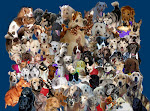Sen-Chan: Yes, she is back! #1 finally returned from the Percheron National Championships late yesterday evening. But then, she left again at dawn this morning to take South African friends she had met there to a nearby stud farm. And she took Tom with her, so I was left alone again and all I could do was reminisce about previous lives when I was properly honoured, in Ancient Egypt...
Tom: Yes, #1 did take me with her this morning but she left me in the car when she went to see the big horses, and didn't come back for the longest time. And once we got home, she told me I was filthy from my walk in the woods with Pie and Ms. A yesterday and she took the hose to me! And the shampoo! And finally the towels which are definitely my favourite part!

#1: In response to the great show of interest, I am delighted to share some of my photos from the French National Percheron Championships with you. Many of you may already know this but the Percheron is a breed of heavy horse that was used for both farm labour and pulling carriages in the old days. It is believed that the breed was originally created by crossing large local mares with Arabian stallions brought back from the crusades. After the Second World War, when tractors and cars became prevalent, the breed was almost abandoned for decades but it has experienced a real resurgence in recent years, helped by the import of some stallions from the States and Canada where a lighter version of the breed had been developed. The annual championships are held at one of France's national stud farms, the Haras du Pin, which is most spectacular location. Here is the entrance to the chateau, with the inner courtyard, at dusk:

On the first day of the championships, stallions are presented in this courtyard. This year, there were 87 of them, all two and three years old. This is the venue where they are approved for breeding and a few are actually purchased by the National Stud.
Here is a particularly huge fellow:
The stallions often like to be with their buddies and get very nervous when they are separated...
Traditionally Percherons are born black (a coat of night), and as they grow older, they become dappled (a coat of stars), getting lighter grey and often pure white with age (a coat of clouds). But some always stay black, and some grow white very young. For shows, both manes and tails are braided, using coloured wool, in a very different fashion from Clydesdales, for example... By the way, it is illegal to dock tails in Europe so they are always carried long.
The second day of the championships is Girls' Day. This year, there were 235 mares, many of them with their foals. This event is held in the large fields at the foot of the Haras du Pin chateau.
It's always a special treat to see so many foals
And so many horses together are a spectacular sight
None more than the final presentation of the championships in which breeders can present as many of their mares and foals as they wish, all tied together side by side and made to move as one. This year, the winner was an "18-horse power" team! I could only get 14 of them into the lens of the camera!
In conclusion, a scene from early this morning. We walked into a field at a nearby farm and the mares and their foals all came towards us to say hello. Percherons are real gentle giants and have a very friendly disposition
















































































